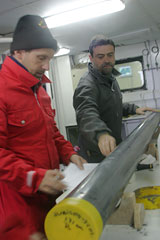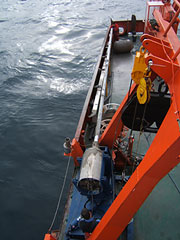

 | |||||||||||||
|
|
Journals 2007/2008Megan O'Neill
August 4, 2007 At 8:30 this morning the crew for the cores got set up and started the process. It was so interesting to watch this detailed orchestra of so many people. They have the naval guys working the cranes and the core technicians have the liners already in the steel samplers attached to the piston weight. At first, they had a little trouble lining up the piston sampler, but after much work got it set up to lower into the water. I videotaped the whole process to share with my classes. I have never seen this process, but have experienced drilling monitoring wells on land when I was an environmental consultant. It is a different creature when you add the dynamics of the water and drilling at 1800m! They explained several times that you can have a range for the target, but it is sort of like throwing out the dice to see what you hit. There are so many variables to consider, too-The cap on the end has to catch the sample or it will all fall out on the way back up, water can block some of the sample, etc. The cables lower the sampler at a speed of 4m/s, so it took approximately 40 minutes to lower it, take the sample and 40 minutes to raise it. The sample is collected by the piston corer hitting the bottom first and setting off the other sampler through the suction of air through it as it goes through the sediment. Angelo explained that they will know that they have a usable sample when it comes up muddy looking. Sure enough, when it arrived at the surface, it was covered in gray mud. Everyone was jubilant, but not until it was on deck and the liner was pulled out to verify the sample. It was collected at 75.98300ºN and 13.93507°E. The total length of the sample was 2.8m out of the 5m liner and the trigger had 1.43m out of 2m, which was very good. According to Alena, the trigger creates the vacuum in the other corer, which will always reduce the amount in the corer. Therefore, 2.8m is pretty good. On the second core sample at 75°13.7073'N and 14°35.385'E 6.4m were collected from the 7.4m liner and the trigger was empty. Alena says this was possibly due to fine sands that may have fallen out on the way up. Everyone was elated with the 6.4 m sample and Angelo said if we were sampling in the Mediterranean, as he has done in the past, they would celebrate by jumping into the water. Unfortunately, we would not last long if we celebrated this way here!
|
||||||||||||

